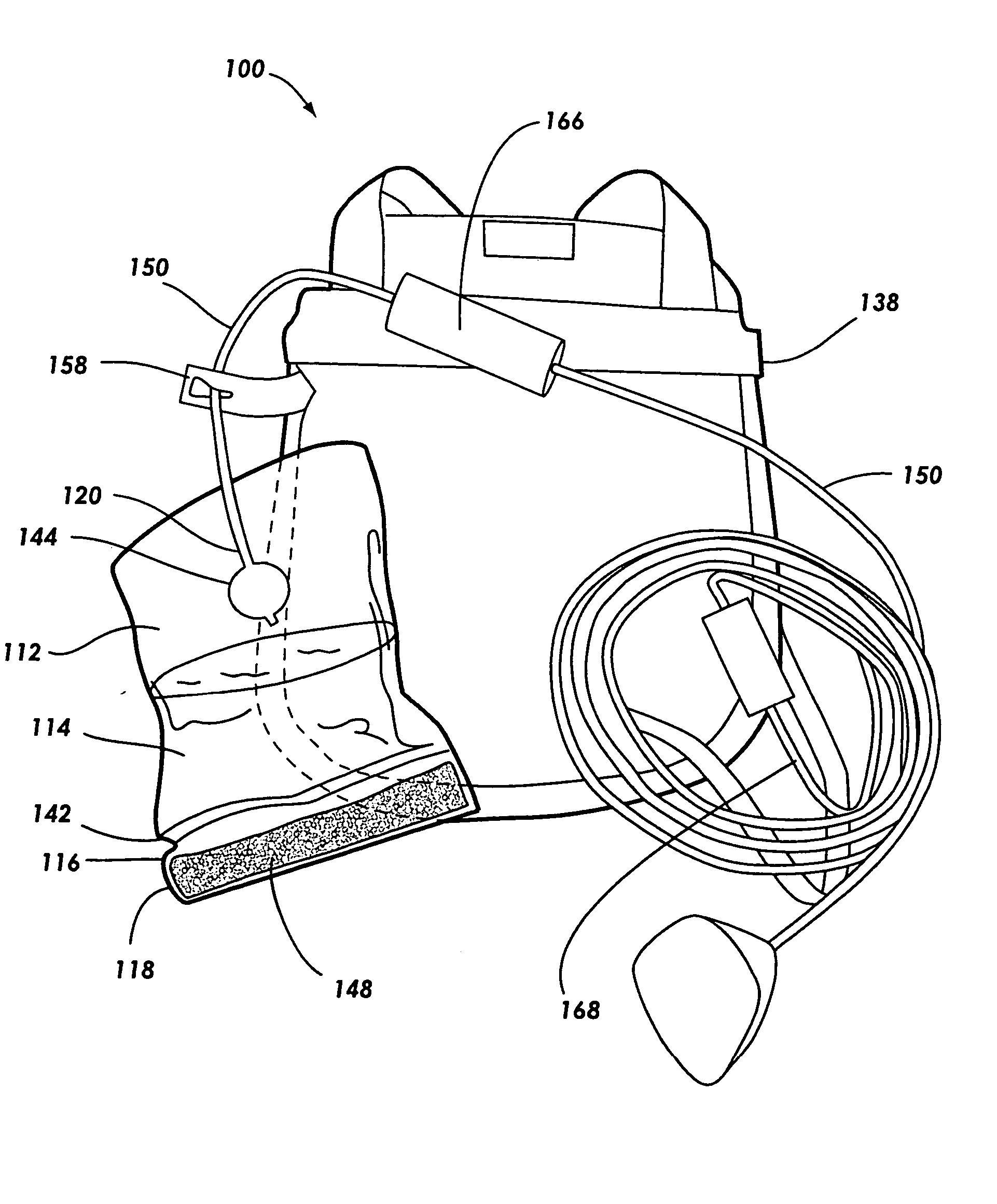[0017] The portable oxygen generation
system of the invention functions as described above, but alternate embodiments may contain additional features. These can include a humidifying chamber. When oxygen is generated in the flexible bladder, it is part of an
exothermic reaction and enters the conduit and the
oxygen delivery mask in a fairly warm and dry state. An inline chamber in the conduit may be helpful to cool the oxygen before it reaches the delivery
mask. It also has the effect of adding some
humidity to the oxygen. If the humidifying chamber is structured for bubbling, observing bubbles passing through the humidifying chamber serves to assure the user that oxygen is being generated and passing through the conduit to the delivery
mask.
[0021] Another feature of the oxygen generation
system of the invention is an outer pouch. An outer pouch serves several functions, and can be quite important for the oxygen generation
system. One function it serves is that it protects the flexible bladder from
external injury, so that it is less likely to be ripped or torn. The outer pouch is also preferably liquid proof, and thus would serve as a containment vessel if the liquid in the flexible bladder leaked. Another function of the outer pouch is to act as a holder for the flexible bladder while the flexible bladder is generating oxygen. Many oxygen generation reactions are exothermic reactions that can produce a considerable amount of heat. Thus, it might be uncomfortable for a user to hold the flexible bladder while it is generating oxygen. The outer pouch serves the purpose of providing an insulating carrying case, which insulates the user from the heat generated during oxygen production. The outer pouch can include a shoulder strap, or a
handle. It can also be provided with a hole through which the
air line can pass, so that the outer pouch and the flexible bladder can be placed in an oxygen generation cabinet.
[0028] In the case of the bladder with chambers separated by weak seals, when the bladder is squeezed, the differences in volumes on the sides of the chambers and between the chambers create an uneven force along the walls. These weak seal walls will then rupture and fail when the chambers are pressed. When this occurs, a mixture of materials between the varying chambers exists, and as this takes place, oxygen is produced as the
chemical reaction between the various items within the chambers occurs. Once the materials have been mixed, and oxygen begins to be formed, the oxygen can be exited from the flexible bladder and delivered through the device to a mask, nasal canula or other
delivery system to an individual. This is done by opening the tubing clamp. When the tubing clamp is open, oxygen will flow through the conduit, past the
check valve into the humidifier chamber. The presence of bubbles ascending to the
liquid line within the humidifier chamber gives positive identification to the individual utilizing the device that oxygen is being produced and is passing through the chamber. The mixture of liquid with the oxygen also makes these things more palatable.
[0029] Along the delivery device conduit may be located a hydrophobic filter chamber that allows the oxygen to pass through for use but prevents the passage of liquid through. This is a safety feature, which prevents unwanted aspiration of liquid from the material into the
respiratory system of the individual utilizing the device. Another design to prevent liquid from entering the conduit is to utilize a liquid trap in which liquid entering with the oxygen is collected in a cup, and only gas passes out of the liquid trap.
[0030] The present invention provides a dependable portable emergency
oxygen system that can have an indefinite
shelf life and provide immediate capabilities for oxygen production and use without the requirements of filling with liquid, filling with water, adding catalysts, or other things that may be required in other methods. The present invention can be variously modified to use in a variety of environments such as emergency medical situations, armed conflicts, field use by military and rescue personnel, home
first aid, building and tank evacuation, mountain climbing,
airplane flying, and other uses. In addition, because the devices are fully self-contained, they could be utilized as a
backup in other activities where a
respirator is used. Due to the fact that the device is made of non-compressed materials, they are much less bulky and less of an environmental and ecological
hazard than those devices that use compressed gas in cylinders.
[0033] In one embodiment, the bag would be built and sterilized and the components then filled in the appropriate chambers. The tubing
assembly would be stored with the flexible bladder, but not attached to the bag. This would allow the
oxygen system to be stored until the
time of use. This provides a self-pressurizing
oxygen delivery system that may be utilized in a variety of circumstances including on the
battlefield or other areas where access to water is unavailable. The invention is intended to be a disposable unit, therefore eliminating the need for excess storage. In addition, because the device is collapsible after use, the amount of space and weight required to haul the device is significantly decreased.
 Login to View More
Login to View More 


